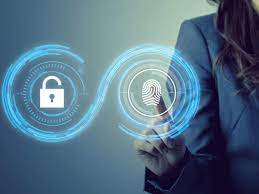Biometrics in Digital Security
Blog Credit: Trupti Thakur
Image Courtesy: Google
What is biometrics?
Automatic recognition of people based on their anatomical (e.g., face, fingerprint, iris, retina) and behavioral (e.g., signature, posture) individualities is called Biometrics. It is a form of information that helps in identifying one’s physical characteristics such as psychosomatic, behavioral characteristics, etc.
What is a Biometric System?
A biometric system is an advanced technology that assists in identifying an individual’s biological, behavioral, or both traits as input then verifies it, and at last, identifies the individual as an authorized user.
Biometric authentication is a security process that relies on the unique biological characteristics of individuals to verify they are who they say they are. Biometric authentication systems compare physical or behavioral traits to stored, confirmed, authentic data in a database. If both samples of the biometric data match, authentication is confirmed. Typically, biometric authentication is used to manage access to physical and digital resources, such as buildings, rooms, and computing devices.
Biometric identification uses biometrics, such as fingerprints or retina scans, to identify a person, whereas biometric authentication is the use of biometrics to verify people are who they claim to be.
Biometric authentication methods
The following technologies can be used to digitally identify people or grant them permission to access a system:
- Chemical biometric devices
- DNA (deoxyribonucleic acid) matching uses genetic material to identify a person.
- Visual biometric devices
- Retina scans identify subjects by analyzing the pattern of blood vessels at the back of their eyes.
- Iris Recognition uses a picture of the iris to identify people.
- Fingerprint scanning identifies people based on their fingerprints.
- Hand geometry recognition verifies identity or authorizes transactions using a mathematical representation of the unique characteristics of people’s hands. This is done by measuring the distances between various parts of the hand, including finger length, finger breadth and the shape of the valleys between the knuckles.
- Facial Recognition relies on the unique characteristics and patterns of people’s faces to confirm their identity. The system identifies 80 nodal points on a human face, which make up numeric codes called faceprints.
- Ear authentication verifies identity based on users’ unique ear shape.
- Signature recognition uses pattern recognition to identify individuals based on their handwritten signature.
- Vein or vascular scanners
- Finger Vein ID identifies individuals based on the vein patterns in their finger.
- Behavioral Identifiers
- Gait analyzes the way people walk.
- Typing recognition establishes people’s identity based on their unique typing characteristics, including how fast they type.
- Auditory biometric devices
- Voice ID identifies individuals by their voice and relies on characteristics created by the shape of the mouth and throat.
What are the components of biometric authentication devices?
A biometric device includes three components: a reader or scanning device, technology to convert and compare collected biometric data, and a database for storage.
A sensor is a device that measures and captures biometric data. For example, it could be a fingerprint reader, voice analyzer, or retina scanner. These devices collect data to compare to the stored information for a match. The software processes the biometric data and compares it to match points in the stored data. Most biometric data is stored in a database that is tied to a central server on which all data is housed. However, another method of storing biometric data is cryptographically hashing it to allow authentication to be completed without direct access to the data.
What are the use cases of biometric authentication?
Law enforcement
Law enforcement and state and federal agencies use different kinds of biometric data for identification purposes. These include fingerprints, facial features, iris patterns, voice samples and DNA.
For example, the Automated Fingerprint Identification System, or AFIS, is a database that is used to identify fingerprints. It was first used in the early 1970s as a way for police departments to automate their otherwise manual fingerprint identification process, making it quicker and more effective. In the past, a trained human examiner had to compare a fingerprint image to the prints on file. If there was a match, the examiner would double check the two prints to verify the match. Today, AFIS can match a fingerprint against a database of millions of prints in a matter of minutes.
Travel
An electronic passport (e-passport) is the same size as a conventional passport and contains a microchip that stores the same biometric information as a conventional passport, including a digital photograph of the holder. A chip stores a digital image of the passport holder’s photo, which is linked to the owner’s name and other identifying information. The e-passport is issued electronically by a country-issuing authority, which checks the identity of the applicant through fingerprints or other biometric information and confirms the data in the chip with the information provided by the applicant before issuing the passport.
Healthcare
Hospitals use biometrics to more accurately track patients and prevent mix-ups, while clinics and doctors’ offices implement biometric authentication to keep their patients’ information secure. Using biometric data, hospitals can store, as well as access, a patient’s medical history. This information can be used to ensure the right patient gets the right care, whether that means faster identification in emergency situations or preventing medical errors.
What are the advantages and disadvantages of biometric authentication?
Biometric authentication is both convenient and secure. Since biometric authentication uses unique characteristics for verification, they are difficult to replicate. Traditional methods, such as passwords or ID cards, are not as secure because they can be stolen or guessed easily.
While biometrics offers many advantages for particular industries, there are controversies surrounding its usage. For example, organizations may overlook the security of these data-driven security schemes. If bad actors capture biometric data when it is being transmitted to a central database, they can fraudulently replicate that data to perform another transaction. For example, by capturing an individual’s fingerprint and using it to access a fingerprint-secured device, the bad actors could access sensitive data, such as private messages or financial information.
Another potential issue with biometric authentication is that, once a system has been implemented, an organization may be tempted to use the system for functions beyond its original intention, which is known as function creep. For example, a company may find the technology useful for employee monitoring and management, but once a biometric system has been installed, the organization may find that it has the ability to track exactly where an employee has been.
Blog By: Trupti Thakur

08
JunBiometrics In Digital Security
Jun 08, 2023Recent Blog
Quantum Gravity Gradiometer PathFinderApr 28, 2025
The TechKriti 2025Apr 26, 2025
India’s First Quantum Computing VillageApr 24, 2025
India’s Achievement In QKDApr 22, 2025
The V2G TechnologyApr 21, 2025




